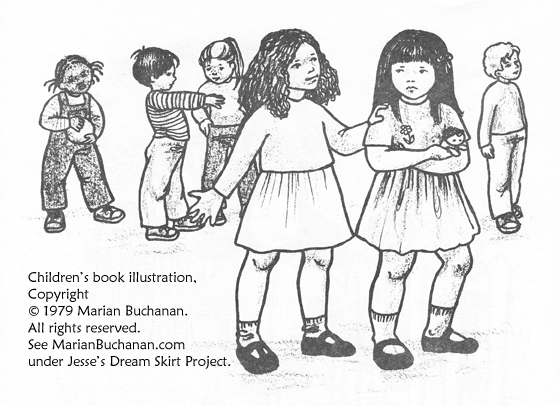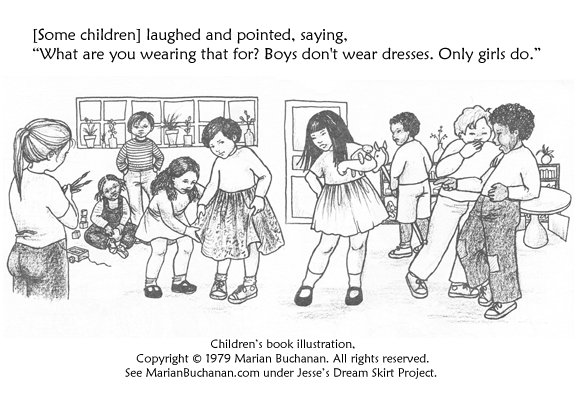Overview, First Reactions, and the Dynamics of Shaming
I’ve mentioned in an earlier post that there are differences between the two versions of the story Jesse’s Dream Skirt. I’ve already covered the differences in the way the mother is portrayed. Now it’s time to look at the two different versions of the children and how they react to Jesse wearing a skirt to daycare. This will take several posts, but let me first give you an overview.

In both versions of the story, there are 4 stages involving the other children:
- how the children react when they first see Jesse in a skirt;
- what is said that triggers Jesse getting upset and running away crying;
- what arguments are made during the discussion that the teacher initiates with the whole group;
- how the children join in when the teacher initiates wearing a piece of cloth like a skirt.
At all of these stages there are differences between the two versions, relating to one or more of the following:
- emotional intensity;
- logical sequence and relevance of ideas;
- involvement of specific children;
- the message conveyed.
With this overview in mind, let’s now look at the children’s first reactions and what it is that sets off Jesse’s stronger emotions.
First reactions and triggers
In both versions of the story, there are some children who are perfectly okay with Jesse’s skirt right from the beginning (“Some looked and then smiled.”), while others start out perhaps a little unsure of what to think (“Others just plain stared.”). But a few of the children react negatively, and this is, of course, what creates the opportunity for the story.
In the 1977 magazine version, the interaction between Jesse and the anti-skirt children flares up very quickly. Right away these children “echoed, bellowed, and laughed, saying, ‘Boys don’t wear dresses. Only girls do.'” Jesse shouted back, “I can wear what I want!” and immediately “ran off crying.”
In the 1979 book version, the negative reaction starts out more moderately. They do laugh, and in this version they also point, but there is no “echoing” or “bellowing” and it comes across as being mostly a knee-jerk reaction of conformity when they say, “What are you wearing that for? Boys don’t wear dresses. Only girls do.”

Jesse’s words are the same as in the earlier version (“I can wear what I want!”) but he doesn’t shout it, he simply “answers back,” which conveys more of an assertiveness than anger or upset.
It takes a more deliberately nasty tone and teasing to get Jesse upset enough to run away crying. He does so only after John shouts, “Jesse is a sissy,” and Mary sneers, “Where’s your purse and dolls?”
Given that Jesse had already been warned by his mother that some of the children might make fun of him, and had shown determination to wear his skirt anyway, I think this slower progression of emotions seems more in keeping with the expectations that were set up earlier in the story. More importantly perhaps, it also allows for a more detailed look at how bullying can unfold, and an opportunity to discuss the dynamics with children to whom the story is read — exploring what can tend to set off one’s emotions and why.
The dynamics of shaming
Some people think the way children should be taught to respond to name-calling is to think, “Sticks and stones may break my bones but names will never hurt me.” But realistically speaking, being called a name does hurt, and just because it’s feelings being hurt rather than a body being wounded, doesn’t mean it’s okay.
Why does it hurt? More than the words themselves, it’s the intention to hurt that hurts. Indeed, this is what distinguishes bullying from simple blundering. Mary could be using exactly the same words (“Where’s your purse and dolls?”) to make a genuine and neutral enquiry in a perfectly friendly tone – for instance, if she was talking to a female child with whom she was about to play a make-believe game of being mommies (hence the dolls as the children) doing grown-up things like going shopping (hence the purse). And maybe if a little girl with a different attitude asked the same thing of a little boy with whom she was about to play, she might not mean any offense by it, and if he took offense, her innocently-made enquiry would merely be a blunder, because of his attitude rather than hers. But Mary’s tone with Jesse indicates that, in this case, it’s not meant to be taken as a neutral enquiry. She is deliberately trying to shame Jesse, and so is John with his name-calling.
It’s worth exploring where the urge to shame comes from in the first place. In the book version of the story, the progression of emotions starts with a sentence that was not in the original version: “What are you wearing that for?” This conveys what might be simply a sense of “wait a minute, that’s not right!” – a jolt to the worldview into which the children have been inculcated by the grown-ups and media around them. The feeling might be one of confused discomfort to begin with, rather than outright hostility. Their view of the proper order of things (“Boys don’t wear dresses. Only girls do.”) has been upset, and they’re reacting automatically in an attempt to redress this.
When Jesse doesn’t buy into this “rule” (“I can wear what I want!” he answers back), the children whose worldview has been jostled escalate their attempt to reinstate the “proper” order of things. Resorting to name-calling and sarcasm is a reactive way of trying to reinstate dominance of their worldview and squash the perceived threat to it. Of course, as young children, they don’t realize how they’re feeling threatened, but are simply reacting automatically, in a way that they perceive as normal.
The way the story then proceeds to explore these initial reactions is by having the children share argumental points and personal experiences, but it doesn’t deconstruct the shaming reaction in terms of what emotions it comes from. I think the limitation in scope is appropriate for the story itself, but in real life situations, and in discussing the story with children to whom the story is read, I wonder if it might be helpful to at least touch on the bully’s side of the emotional equation too. Many people have a tendency to reduce perpetrators to the role of villain instead of seeing them as the multi-dimensional (and in this case, developing) beings that they are. Exploring those other dimensions contributes to a win-win approach in which a behavioral problem can be resolved without redirecting the shaming towards the initial shamers. The purpose of such an exploration is not to excuse the behavior, but to help all sides understand it — to counteract the tendency to villainize, to facilitate forgiveness — and more importantly, to make an alternative response easier for the bully to find.
As the story continues past the children’s initial reactions, so too do the differences between the two versions of the writing and narrative. There are again differences in emotional intensity, but also in the messages conveyed and what arguments are put forth to make the case for those messages. That part of the story deserves a detailed analysis as well, so I’ll explore it in a separate, dedicated post a little later.
In the meantime, I’d love to hear your comments on what’s been covered so far.
